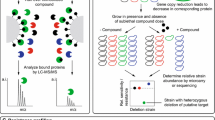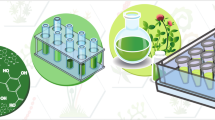Abstract
Natural products have served as a major source of drugs for centuries, and about half of the pharmaceuticals in use today are derived from natural products. The aim of this review is to provide an overview of the continuing central role of natural products in the discovery and development of new pharmaceuticals. In this context, selected examples of important natural product-derived drugs are cited, focusing on some of the most recent introductions to the clinical setting, and a brief overview of some of the important recent developments and remaining challenges in the process of discovering and developing bioactive natural products is provided. Interest in natural products research is strong and can be attributed to several factors, including unmet therapeutic needs, the remarkable diversity of both chemical structures and biological activities of naturally occurring secondary metabolites, the utility of bioactive natural products as biochemical and molecular probes, the development of novel and sensitive techniques to detect biologically active natural products, improved techniques to isolate, purify, and structurally characterize these active constituents, and advances in solving the demand for supply of complex natural products. Opportunities for multidisciplinary research that joins the forces of natural products chemistry, molecular and cellular biology, synthetic and analytical chemistry, biochemistry, and pharmacology to exploit the vast diversity of chemical structures and biological activities of natural products are discussed.
Similar content being viewed by others
REFERENCES
D. D. Soejarto and N. R. Farnsworth. Tropical Rain Forests: Potential Source of New Drugs? Perspectives Biol. Med. 32:244–256 (1989).
V. E. Tyler, L. R. Brady, and J. E. Robbers. Pharmacognosy, Ninth Edition, Lea & Febiger, Philadelphia, 1988.
X.-M. Cheng. To Market, To Market—1993. In J. A. Bristol (ed.), Annual Reports in Medicinal Chemistry, Academic Press, vol. 29, 1994, pp. 331–354.
S. H. Ferreira. A Bradykinin-Potentiating Factor (BPF) Present in the Venom of Bothrops jararaca. Brit. J. Pharmacol. 24:163–169 (1965).
S. H. Ferreira, L. J. Greene, V. A. Alabaster, Y. S. Bakhle, and J. R. Vane. Activity of Various Fractions of Bradykinin Potentiating Factor against Angiotensin I Converting Enzyme. Nature 225:379–380 (1970).
S. H. Ferreira, D. C. Bartelt, and L. J. Greene. Isolation of Bradykinin-Potentiating Peptides from Bothrops jararaca. Biochem. 9:2583–2593 (1970).
M. A. Ondetti, B. Rubin, and D. W. Cushman. Design of Specific Inhibitors of Angiotensin-Converting Enzyme: New Class of Orally Active Antihypertensive Agents. Science 196:441–444 (1977).
J. G. Hardman, L. E. Limbird, P. B. Molinoff, R. W. Ruddon, and A. G. Gilman (eds.), The Pharmacological Basis of Therapeutics, Ninth Edition, McGraw-Hill, New York, 1996.
R. B. Barlow and H. R. Ing. Curare-Like Action of Polymethylene Bis-Quaternary Ammonium Salts. Brit. J. Pharmacol. Chemother. 3:298 (1948).
I. A. McDonald, N. Cosford, and J.-M. Vernier. Nicotinic Acetylcholine Receptors: Molecular Biology, Chemistry and Pharmacology. In J. A. Bristol (ed.), Annual Reports in Medicinal Chemistry, Academic Press, vol. 30, 1995, pp. 41–50.
J. P. Hieble and R. R. Ruffolo. Pharmacology of Neuromuscular Transmission. In P. L. Munson, R. A. Mueller, and G. R. Breese (eds.), Principles of Pharmacology: Basic Concepts & Clinical Applications, Chapman & Hall, New York, 1995, pp. 145–159, 1734.
J. Berdy (ed.), CRC Handbook of Antibiotic Compounds. CRC Press, Inc., Boca Raton, Florida, 1980.
P. I. Trigg, In, H. Wagner, H. Hikino, and N. R. Farnsworth (eds.), Economic and Medicinal Plant Research, Academic Press, London, vol. 3, 1989, pp. 19–55.
Y.-L. Wu and Y. Li. Study on the Chemistry of Qinghaosu (Artemisinin). Med. Chem. Res. 5:569–586 (1995).
I.-S. Lee and C. D. Hufford. Metabolism of Antimalarial Sesquiterpene Lactones. Pharmac. Ther. 48:345–355 (1990).
H. G. Davies and R. H. Green. Avermectins and Milbemycins. Nat. Prod. Repts. 3:87–121 (1986).
K. Awadzi, K. Y. Dadzie, H. Schulz-Key. D. R. W. Haddock, H. M. Gillies, and M. A. Aziz. The Chemotherapy of Onchocerciasis X. An Assessment of Four Single Dose Treatment Regimes of MK-933 (Ivermectin) in Human Onchocerciasis. Ann. Trop. Med. Parasitol 79:63 (1985).
B. M. Greene et al. Comparison of Ivermectin and Diethylcarbamazine in the Treatment of Onchocerciasis. New Engl J. Med. 313:133 (1985).
S. G. Bradley and F. Marciano-Cabral. Antiparasitic Drugs. In P. L. Munson, R. A. Mueller, and G. R. Breese (eds.), Principles of Pharmacology: Basic Concepts & Clinical Applications, Chapman & Hall, New York, 1995, pp. 1437–1473.
T. L. Loo and E. J. Freireich. Cancer Chemotherapeutic Drugs. In P. L. Munson, R. A. Mueller, and G. R. Breese (eds.), Principles of Pharmacology: Basic Concepts & Clinical Applications, Chapman & Hall, New York, 1995, pp. 1475–1516.
M. E. Wall and M. C. Wani. Camptothecin and Taxol: Discovery to Clinic—Thirteenth Bruce F. Cain Memorial Award Lecture. Cancer Res. 55:753 (1995).
P. B. Schiff, F. Fant, and S. B. Horwitz. Promotion of Microtubule Assembly In Vitro by Taxol. Nature 277:665–667 (1979).
M. E. Wall, M. C. Wani, C. E. Cooke, K. H. Palmer, A. T. McPhail, and G. A. Sim. Plant Antitumor Agents. I. The Isolation and Structure of Camptothecin, a Novel Alkaloidal Leukemia and Tumor Inhibitor from Camptotheca acuminata, J. Am. Chem. Soc. 88:388 (1966).
H. Sahelin and A. von Wartburg. The Chemical and Biological Route from Podophyllotoxin Glucoside to Etoposide: Ninth Cain Memorial Award Lecture. Cancer Research 51:5–15 (1991).
H. Stahelin and A. von Wartburg. In E. Jucker (ed.), Progress in Drug Research, Birkhauser-Verlag, Basel, vol. 33, 1989, pp. 169–266.
A. D. Buss and R. D. Waigh. Natural Products as Leads for New Pharmaceuticals. In Manfred E. Wolff (ed.), Burger's Medicinal Chemistry and Drug Discovery, Fifth Edition, Vol. 1, John Wiley & Sons, Inc., New York, 1995, pp. 983–1033.
G. R. Pettit, C. L. Herald, D. L. Doubek, D. L. Herald, E. Arnold, and J. Clardy. Isolation and Structure of Bryostatin 1. J. Am. Chem. Soc. 104:6846–6848 (1982).
R. A. Heyman, D. J. Mangelsdorf, J. A. Dyck, R. B. Stein, G. Eichele, R. M. Evans and C. Thaller. 9-Cis Retinoic Acid Is a High Affinity Ligand for the Retinoid X Receptor. Cell 68:397 (1992).
E. A. Allegretto, M. R. McClurg, S. B. Lazarchik, D. L. Clemm, S. A. Kerner, M. G. Elgort, M. F. Boehm. S. K. White, J. W. Pike and R. A. Heyman. Transactivation Properties of Retinoic Acid and Retinoid X Receptors in Mammalian Cells and Yeast. J. Biol. Chem. 268:26625 (1993).
A. M Nadzan. Retinoids for the Treatment of Oncological Diseases. In J. A. Bristol (ed.), Annual Reports in Medicinal Chemistry, Academic Press, vol. 30, 1995, pp. 119–128.
D. J. Gordon and B. M. Rifkind. 3-Hydroxy-3-Methylglutaryl Coenzyme A (HMG-CoA) Reductase Inhibitors: A New Class of Cholesterol-Lowering Agents. Ann. Int. Med. 107:759–761 (1987).
A. G. Brown, T. C. Smale, T. J. King. R. Hasenkamp and R. H. Thompson. Crystal and Molecular Structure of Compactin, A New Antifungal Metabolite from Penicillium brevicompactum. J. Chem. Soc., Perkin Trans. I. 1165–1170 (1976).
A. W. Alberts, J. Chen, G. Kuron, V. Hunt, J. Huff, C. Hoffman, J. Rothrock, M. Lopez, H. Joshua, E. Harris, A. Patchett, R. Monaghan, S. Currie, E. Stapley, G. Albers-Schonberg, O. Hensens, J. Hirshfield, K. Hoogsteen, J. Liesch, and J. Springer. Mevinolin: A Highly Potent Competitive Inhibitor of Hydroxymethylglutaryl-coenzyme A Reductase and a Cholesterol-Lowering Agent. Proc. Natl. Acad. Sci. USA. 77:3957–3961 (1980).
A. Ruegger, M. Kuhn, H. Lichti, H. R. Loosli, R. Huguenin, C. Quiquerez, and A. Von Wartburg. Helv. Chim. Acta. 59:1075–1092 (1976).
G. S. Noskinm, R. L. Murphy, J. R. Black, and J. P. Phair. Salvage Therapy with Clindamycin/Primaquine for Pneumocystis carinii Pneumonia. Clin. Inf. Dis. 14:183 (1992).
Unpublished results.
H. Doernenburg and D. Knoor. Strategies for the Improvement of Secondary Metabolite Production in Plant Cell Culture. Enzyme Microb. Technol. 17:674–84 (1995).
R. Baum. Combinatorial Chemistry. Chem. Eng. News. 74(7):28 (1996).
L. Katz and S. Donadio. Polyketide Synthesis: Prospects for Hybrid Antibiotics. Annu. Rev. Microbiol. 47:875–912 (1993).
Author information
Authors and Affiliations
Rights and permissions
About this article
Cite this article
Clark, A.M. Natural Products as a Resource for New Drugs. Pharm Res 13, 1133–1141 (1996). https://doi.org/10.1023/A:1016091631721
Issue Date:
DOI: https://doi.org/10.1023/A:1016091631721




